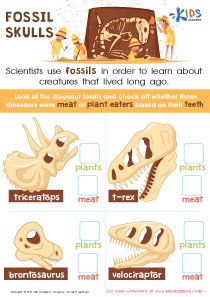Fossils - Lesson for Grade 3, Chapter - Organisms
In the "Fossils" lesson, part of the Organisms unit in Science for Grade 3, students will embark on an exciting journey into the past to learn about the remains of living organisms that have been preserved over millions of years. Through engaging activities such as the "Fossil Skulls Worksheet" and "Studying Fossils Worksheet," students will explore how fossils are formed, the different types of fossils, and what these ancient remains can tell us about the history of life on Earth.
Understanding fossils is important for several reasons. Firstly, it helps students appreciate the vastness of geological time and the process of evolution, showing how life forms have changed and adapted over the ages. Additionally, studying fossils enables students to develop their observation and inference skills, as they learn to examine evidence and make educated guesses about past ecosystems, climates, and the behaviors of prehistoric organisms. This knowledge not only enriches their understanding of the natural world but also fosters curiosity and a scientific mindset, laying a foundation for future learning in earth sciences and biology.


-
Activity 1 / Fossil Skulls Worksheet
We're going on a fossil dig and your child is invited! With this fun and free worksheet, your little explorer will learn that scientists used fossils to learn about creatures of long ago. They'll get to take a look at the teeth of some well-known dinosaurs and decide whether or not each dinosaur was a plant- or meat-eater based on the size and shape of their teeth. It's a dino-riffic way to teach about adaptation and how dinosaurs were able to feed themselves.
-
Activity 2 / Studying Fossils Worksheet
Fossils fascinate children! And why wouldn't they? When we learn about fossils, we're learning about history, and we get to uncover ancient secrets! With this free downloadable, your little scientists will learn what a paleontologist is, and how paleontologists study fossils to learn about plants and animals of long ago. They'll discover that old bones really have value, and that learning about ancient history is fun every day!



